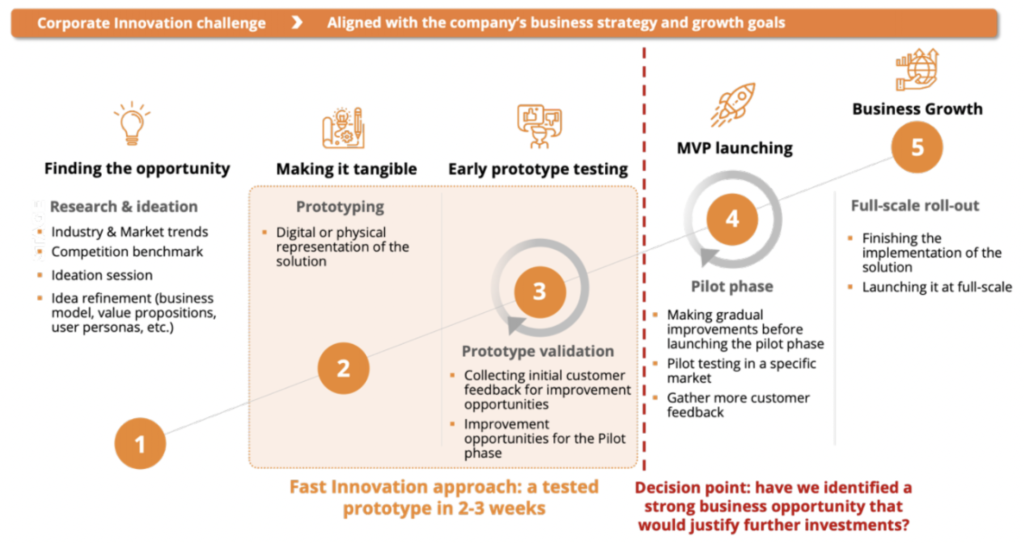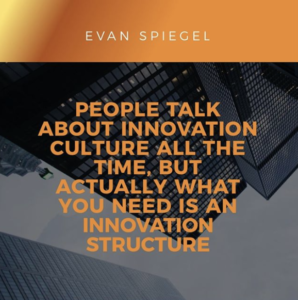Why is Fast Innovation critical?
by: admin
Why is Fast Innovation critical to big companies and how to apply it effectively?
In the corporate world Innovation is a very trendy topic that generates both excitement and fear to executive leaders because of the same issue: Corporate Innovation requires companies to move away from the comfort zone of an established and known business environment, to explore a new and unknown landscape, facing high levels of unpredictability and uncertainty regarding the innovation journey’s output.
Still, we live in an evolving world – now more than ever – where continuous advancements in science, technology, and human values affect our lifestyle and constantly change the way we consume products and services to satisfy our needs.
As a result of living under a moving society, corporate leaders don’t really have a choice but to take the innovation journey if they want to keep the business running in the long term. Indeed, there are notorious cases of global companies that failed to adapt to their industry and market’s pace of change: Nokia, Blackberry or Kodak are all examples of corporations which once dominated their respective global markets, but eventually failed to adapt to their customer’s evolving digital needs (they all feared that innovating in launching new digital products could potentially cannibalize their existing sales). These three companies ended up losing all their market share to fast-growing or highly innovative competitors such as Apple, Samsung, or Canon, who adhered to the growing digital trend. And even if Nokia and Blackberry managed to pivot their core business and are still operating today, it will just take you a few seconds to realize how much they lost if you compare Nokia’s current market capitalization to the one it had in 2000 or Blackberry’s in 2008.
Innovation is therefore critical for the survival of any business regardless of its size. However, a Global Innovation Survey conducted by McKinsey in 2010 (backed by similar findings from the Accenture 2015 US Innovation Survey) detected some surprising insights: while most of the interviewed executives (84%) agreed that innovation is important to the business growth and strategy, only a few of them (6%) said to be satisfied with their organization’s innovation performance or “execution”.
Such figures should definitely raise important questions to Corporate leaders around the innovation challenges they are facing such as: “how can we be sure that we are investing resources (time and money) in developing the right products or services for our customers?” or “how can we correctly align our established business strategy with an effective innovation plan to pursue long-term growth?”
At Ideafoster, we believe the answer to such questions relies on the concept of Fast Innovation. Now, it’s important to point out that the term “fast” can be misleading. “Fast” does not mean that organizations should prioritize speed at every step of the innovation funnel over other important factors that take time such as performing a thorough analysis of the opportunity or planning the required innovation efforts and KPIs.
Indeed, focusing only on speed wouldn’t be advisable as the purpose of corporate innovation shouldn’t be to race with competitors in trying to become the quickest to bombard consumers with new products and services. Companies should rather compete to be the first to deliver a complete solution that effectively meets their target audience’s real needs.
Hence, we use the word “Fast” referring to a vision where, in situations of a new product or service development, agility and speed should be prioritized to find effective ways to involve the target audience as fast and as early as possible in the creation process of the new solution. This vision relies on the obvious benefits of ensuring a certain level of fastness when addressing 3 main purposes:
- Identify, validate, or refute general assumptions regarding potential needs (and consumer pains) that are not being effectively addressed by existing products or services in the market.
- Analyze and understand the target audience’s consumption behavior, preferences, and expectations towards a specific product or service.
- Share with them a tangible representation of a newly proposed solution (product or service). The key is to understand how it is perceived by the target audience and gather valuable feedback regarding its attractiveness and the level of interest it can potentially generate to that specific segment.

The approach could be synthesized as “invest the minimum amount of money and time required to visually show and explain the benefits of your new product or service to your target customer, and ask him the key questions that will provide you the answers and information you need to evaluate the solutions’ business viability”.
We believe this approach can help solve the main problem companies face when innovating: waiting to have the “almost perfect” solution before reaching out to the target audience or before actually showing something tangible to them. As a result, many companies waste a lot of time and money in developing a complete solution without knowing if the target customers are even interested in it…or if they would be willing to spend money on it!
Any business that doesn’t involve its target audience in the earliest stages of its innovation journey (and doesn’t turn them in their innovation partners) will probably not have a clear understanding of their customers real needs, interests, and unsolved pains from existing products. Such a bold approach to innovation is unlikely to deliver great results in terms of innovation KPIs, a fact that explains why many executives are not satisfied with their business’ innovation performance.
Ideafoster is your Fast Innovation partner
Without compromising on the time and effort required in the fundamental phases of market research, idea refinement, or strategic planning, our Fast Innovation approach aims to accelerate the time-to-market of new business solutions once their key value propositions are clearly defined. We help corporations to speed up the prototyping and testing processes of new business ideas, empowering internal innovation teams with extra “innovation muscle”, as well as providing the necessary expertise and digital tools to quickly gather early metrics and feedback from real consumers that will help to guide further innovation efforts in the right direction.
We call our Fast Innovation approach “innovating like a startup”, because it requires a decent amount of speed and agility to prototype and test a business idea in a matter of 1 or 2 weeks (which can sometimes be challenging at large corporations), but doesn’t require large innovation budgets to make it happen.
Ultimately, Ideafoster empowers its clients to innovate based on real-market feedback and make informed decisions before having to invest important amounts of money and time in further innovation stages (MVP development, Pilot testing, and full-scale roll out). We are convinced that Fast Innovation methodologies can effectively help to reduce the associated risk of failure and uncertainty of launching new products and services, as well as provide guidance to achieve profitable growth.





